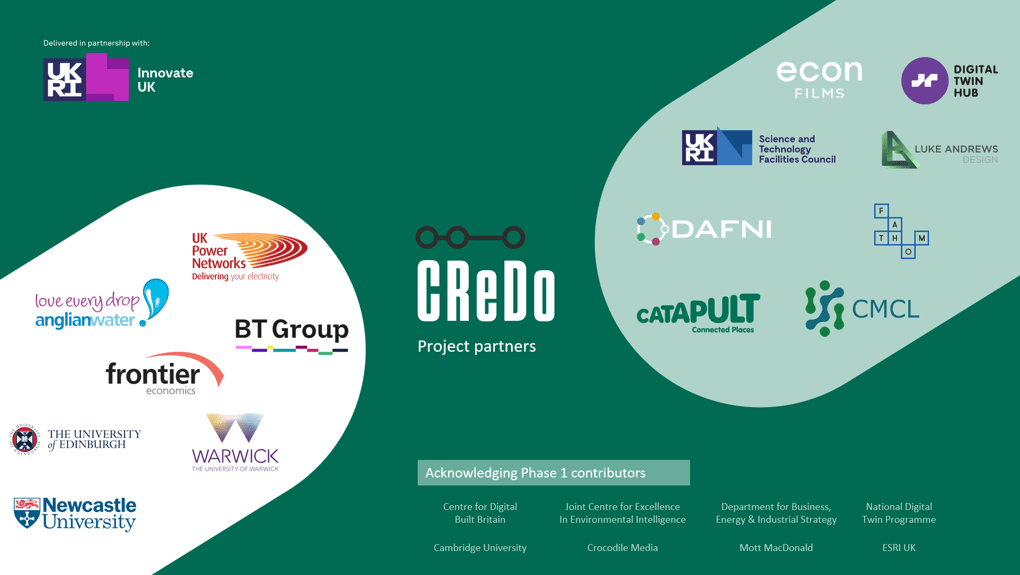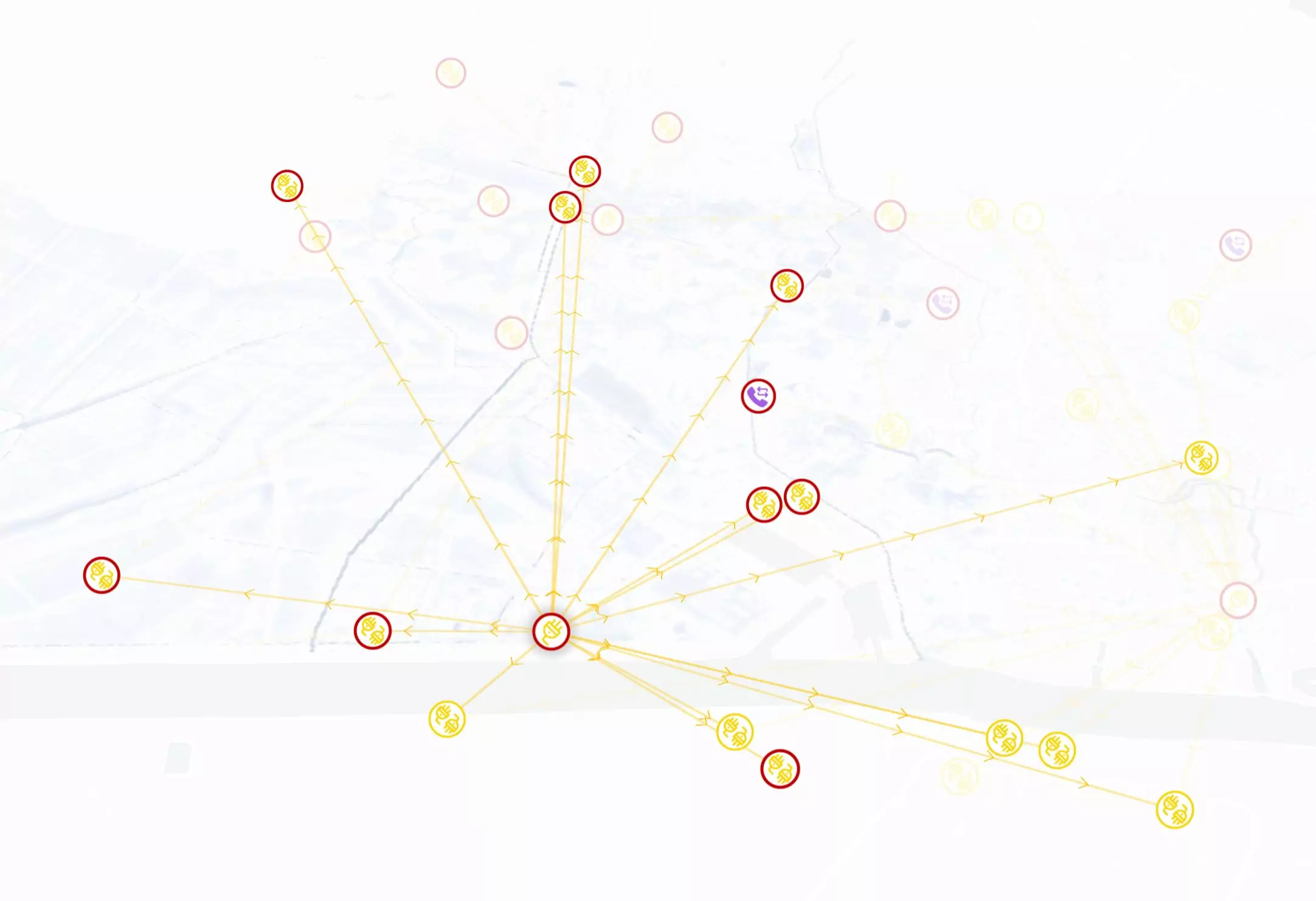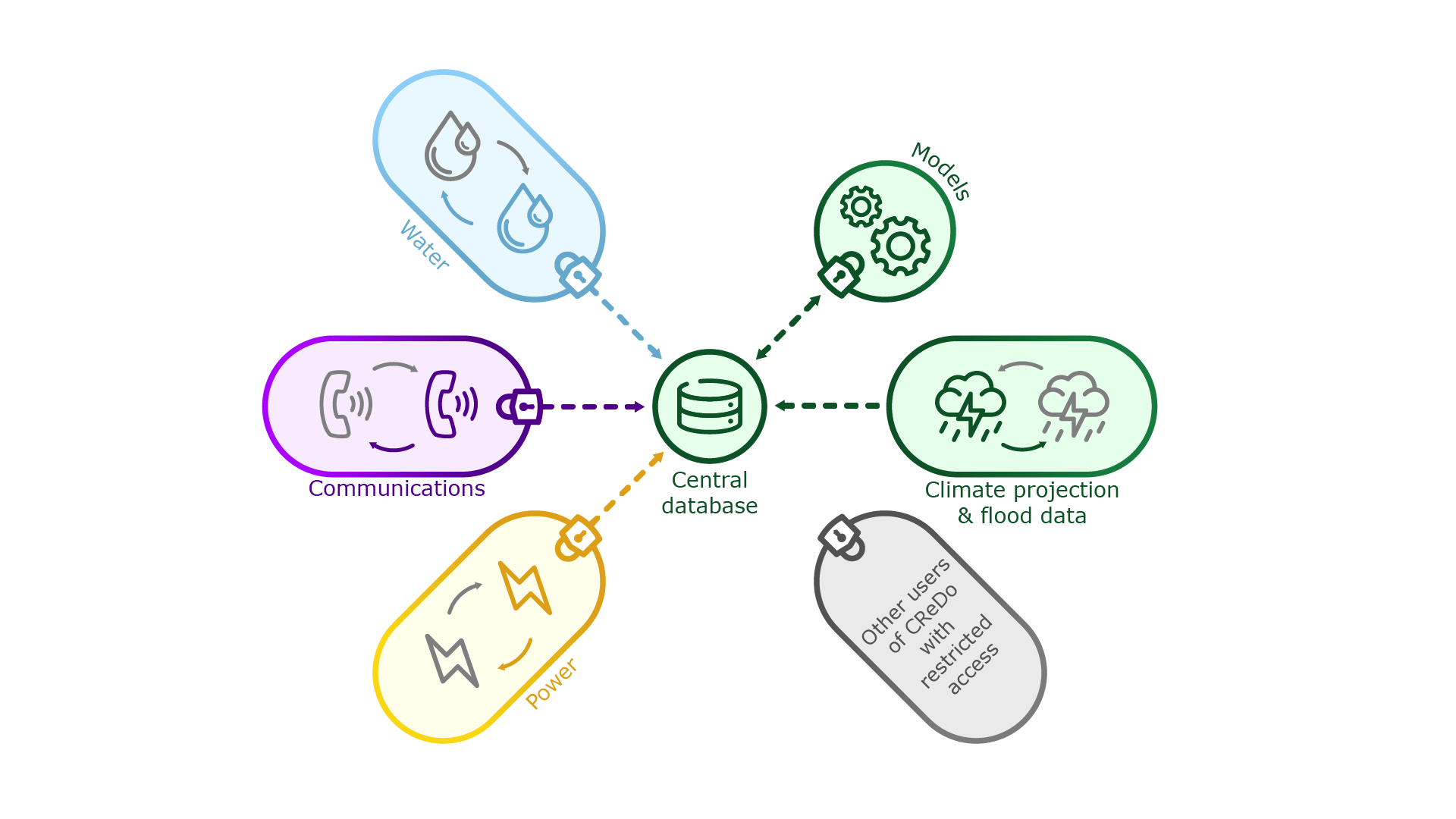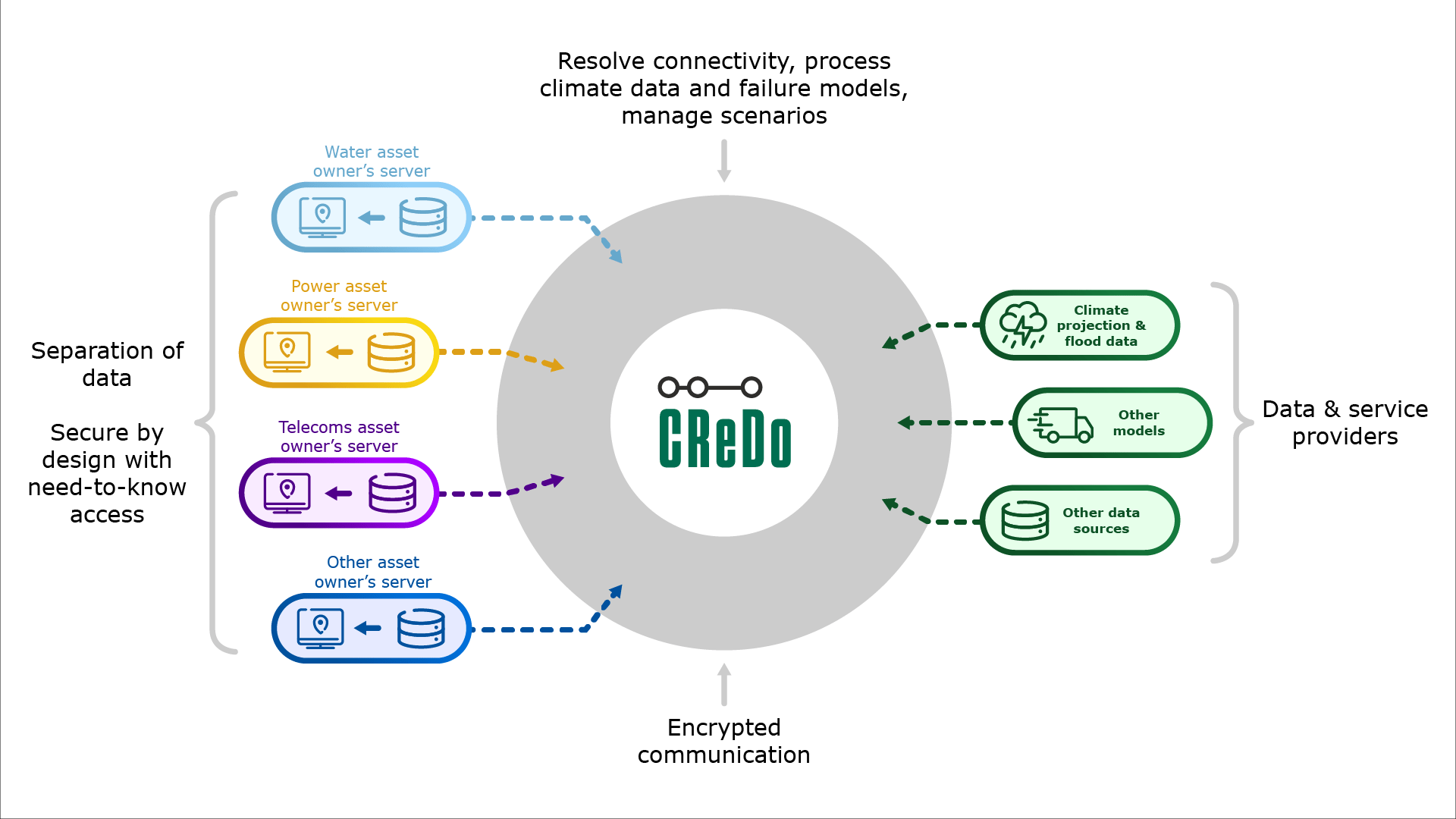CReDo
Climate Resilience Demonstrator (CReDo)

CReDo project logo (CMCL colours)
Introduction
The Climate Resilience Demonstrator (CReDo) is an innovative climate change adaptation project that provides a practical example of how digital twins and connected data can improve climate adaptation and resilience across infrastructure systems, and systems of systems.
CReDo looks specifically at the impact of flooding on energy, water, and telecommunications networks. It demonstrates how those who own and operate such networks can use secure, resilient, information sharing across sector boundaries to mitigate the risk of climate change and reduce the effect of flooding on network performance and service delivery.
Project Partners

Project partners involved in CReDo to date
Phase 1
Overview
Run by the National Digital Twin programme and enabled by funding from UKRI, The University of Cambridge, and Connected Places Catapult, the CReDo project took place in 2022. The vision for the first phase of CReDo was to enable asset owners, regulators and policymakers to collaborate using the CReDo digital twin to make decisions which maximise resilience across the infrastructure system rather than from a single sector point of view.
Data about infrastructure assets is brought together across three infrastructure asset owners — Anglian Water, BT, and UK Power Networks — into a connected digital twin of the infrastructure system network. Combining data sets from three separate organisations into one system model is not straightforward. Principled information management techniques, such as using the appropriate ontologies and striving for semantic precision, are essential to bringing the data together to present the clearest picture of the infrastructure system without inaccuracies.
Coastal and fluvial flood data has been sourced from the Environment Agency and the HiPIMS (High-Performance Integrated hydrodynamic Modelling System) model has been used to generate surface water flooding data that could be expected under a range of future climate change scenarios. Expert elicitation techniques have been employed to understand the impact of the flood scenarios on asset failure within the infrastructure networks. Operational research techniques have been employed to better understand the infrastructure interdependencies and to identify the propagation of asset failure, both across single networks and across the infrastructure system as a whole, resulting from the flood scenarios. This builds a picture of system impact from flooding scenarios that would not otherwise be available to the individual networks or regulators who would only see the impact of flooding on single networks.
This cross-sector figure below, demonstrates the impact of extreme weather events on the infrastructure system and can enable asset owners and regulators to better understand infrastructure interdependencies and identify the most effective, least cost and lowest carbon impact interventions to increase resilience. In addition, the incorporation of live data feeds would demonstrate the potential to inform shorter term operational response leading up to and during extreme weather events.

Interconnected critical national infrastructure networks
CMCL's Contribution
CMCL provided a knowledge graph as the underlying information integration mechanism. The knowledge graph used ontologies to represent the data in a way that enabled interoperability between the data and models within the connected digital twin. This brought many benefits, not least of which are the capacity to select specific models to run for specific assets and the ability to cascade changes efficiently through the network of connected assets, which will be true enablers of more diverse and sophisticated model catalogues in future iterations.
In the CReDo use case, the knowledge graph was regarded as ephemeral; a new one was created at the start of a modelling run, populated with asset data and a single flooding scenario, and used to calculate asset failures due to flooding, the failures were then propagated throughout the system connections (for as many time steps as required) and finally the results exported to the DAFNI datastore for later visualisation.
Upon ingestion, asset and flood data are mapped to ontologies developed specifically for this project, with an abstraction layer above that to enable extensibility. Ontologies help with scaling up and knowledge graphs naturally align with the use of ontologies so this approach is ripe for further development into a future “thin slice” of the National Digital Twin through further development and refinement of the ontology over time. Due to time and resource constraints, this was not an area we were able to explore in this initial phase of the project and thus is a recommended for future investigation, both as a key evolution of CReDo and as an exemplar of how existing frameworks in the digital twin community can be linked to the IMF.
The visualisation tool that was constructed by CMCL was designed to be compatible with a series of outputs from running the full digital twin when considering different flooding scenarios. It was predominantly written using JavaScript and utilised mapping libraries for rendering the geographical data. Development also ensured there was sufficient capability to extend the tool into using new datasets describing any of 1D, 2D, or 3D objects.

Interrogating the direct connections of an asset
Findings
The CReDo project found that it is possible to piece together different datasets across different organisations into one coherent digital twin that conveys a realistic picture of the infrastructure system and the impact of future flooding scenarios caused by climate change. The work undertaken in the first phase of the CReDo project shows what will happen in the future with current networks if we do nothing to adapt. This has been shown with the real data, with synthetic data and in artistic form through the CReDo film. Digital twin projects do not need to be entirely technical in nature, in order to communicate the purpose of the digital twin, such projects need to embrace the human and personal elements of impact.
A key finding of this first phase is that a technical approach alone does not lead to successful delivery. A technical approach needs to be supported through effective communications across a multi-disciplinary team. Adopting an agile approach is beneficial, but still requires a clear technical plan to ensure delivery within set timeframes. In this way, allowing for diversity of approach and interpretation as part of an overall project team is important for harnessing a wide range of capabilities needed to build a connected digital twin where new thinking is required in approaching data sharing, integrating models and developing visualisations. Whilst technology is crucial, people matter most when putting together a connected digital twin.
Phase 2
Overview
The second phase of CReDo, running from April 2022 to March 2023, sought to:
- Move existing CReDo functionality to a distributed architecture where asset owners can host their data assets in their own secure environments , and CReDo can access the relevant data and return insights securely.
- Enable asset owners to see insights from the combined infrastructure network and, by signing up to an additional part of the data licence, a system – level view of the network.
- Build in extensibility to accommodate the future addition of new asset owners and data types.
- Continue to explore and develop methods of promoting interoperability.
- Unlock the strategic resilience planning use – case by enabling asset owners to access real data for both their own and interconnected assets via CReDo.
CMCL's Contribution
CMCL were engaged by Connected Places Catapult to develop a distributed architecture for the CReDo digital twin. The internal data structure of CReDo is based on the use of ontologies to represent information as a knowledge graph. The nodes of the knowledge graph represent data as instances of concepts that describe the type, operational state and location of each asset, and the edges of the graph represent relationships between nodes.
The ability to scale and extend CReDo is critical to understanding the interaction between networks and the impact of cascading risk. These questions motivated the development of an extensible distributed architecture in CReDo Phase 2 to enable the possibility of allowing asset owners to share data and benefit from insights based on the combined network, whilst retaining control of their data within their own IT systems.
The figure below illustrates the centralised data sharing architecture used during CReDo Phase 1 and the distributed architecture demonstrated in CReDo Phase 2.

Centralised phase 1 architecture

Decentralised phase 2 architecture
An additional requirement was for the distributed architecture to be able to host scenarios defined by a combination of asset and hazard data. By comparing different scenarios, we can understand the vulnerability of the combined asset network to different climate scenarios and can understand the difference in implications for different time horizons, 2030, 2050, and 2070 for example, and for different hazards, for example coastal, fluvial and pluvial flooding. The differentiation is important because the type of protection required from saltwater flooding may be quite different from that required for protection for freshwater flooding. The ability to host scenarios additionally provides the possibility of hosting data describing alternative asset bases, for example the planned configuration of the water network in 2030. The ability to assess the implications of future plans on the combined asset network is a vital component of strategic resilience planning.
The distributed architecture used in CReDo Phase 2 is shown in the figure below. The asset owner data is hosted on separate servers, which could be hosted by asset owners in their own IT systems. The distributed architecture enables CReDo to connect securely to a copy of the data held on these servers, and could also enable the possibility to connect directly to asset owner data at source. By separating the data, the architecture seeks to avoid the risks associated with hosting all the data in the same place. Each asset owner server also hosts a visualisation, providing a means to facilitate different views of the insights and data. In the current implementation, a central node is responsible for resolving the connectivity between assets, for running the models that simulate asset failures and the impact across the combined asset network, and for managing scenarios. The architecture enables other data and service providers to contribute to CReDo.

The distributed architecture used in phase 2
Findings
CReDo Phase 2 modified the implementation of the knowledge graph to adopt a distributed architecture that integrates remotely hosted data. The distributed architecture enables the possibility of asset owners sharing data about their infrastructure and receiving insights based on the combined infrastructure network, while simultaneously retaining control of their data assets within their own IT systems.
The use of hierarchical ontologies together with the distributed architecture combine to make CReDo scalable and extensible. CReDo can accommodate:
- Additional infrastructure, for example new asset owners and new types of assets, by defining new specialisations of the core ontology and by connecting to a new server hosting the data. This has been demonstrated by the addition of the NHS data in CReDo Phase 2.
- Other climate projection and weather hazard data. This has been demonstrated by the addition of the flood hazard data supplied by Fathom in CReDo Phase 2.
- Multiple views of the infrastructure data. This has been demonstrated by the availability of both system – wide and restricted views of the infrastructure data in CReDo Phase 2. All views report insights based on the combined infrastructure network, while the restricted views do so without revealing confidential data.
The distributed architecture also permits partially restricted views, for example where a subset of asset owners has an agreement that permits data sharing to calculate insights and visibility of the of the underlying infrastructure data. It is anticipated that the system – wide view may be useful, for example to regulators such as Ofgem, Ofwat and Ofcom, while the flexibility of the (partially) restricted view may remove obstacles to the participation of other asset owners to play a role like Anglian Water, BT and Openreach, and UK Power Networks.
The use of ontologies maximizes outward compatibility. It enables the possibility of mapping data from whatever format is used by asset owners into the CReDo data structure. This is important because it enables compatibility with other data models and standards for information exchange. This allows CReDo to accommodate different asset owners having different data formats. This is critical because digitalisation is journey, and different parties may be in different places on that journey.
The CReDo digital twin has been deployed at STFC in a secure environment within DAFNI. The distributed architecture makes provision for security, access and quality protocols. This has been demonstrated by the development and deployment of a multifactor authentication solution to provide assets owners with secure access to the CReDo on DAFNI.
